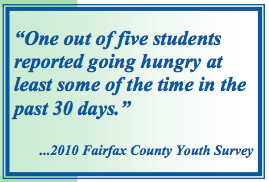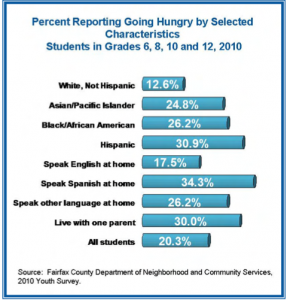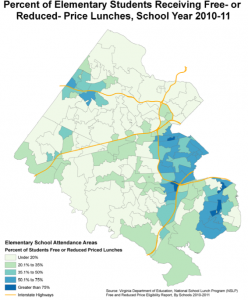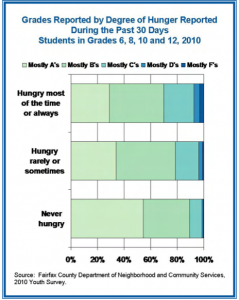Have you very wondered if your grades in school had anything to do with your hunger? These statistics can start to from very young, as early as one’s childhood. In Fairfax County there is a youth survey that is conducted annually for all of the students in sixth, eighth, tenth and twelfth grade. The survey includes questions that asked students questions such as, “How many times has one gone hungry in the past 30 days?

Most of these teens affected in these Fairfax schools are Hispanic and/or African American, and live in single-parent homes. Kids not getting the necessary nutrition is only part of the problem. According to capitalareafoodbank.org, the U.S. Census ACS 2006-2008 found that about 13 percent of people in Northern Virginia are at risk of hunger, and 1 in 6 children in Northern Virginia were at risk of hunger.


The bigger problem that we are faced with when looking at hunger is that it is an issue that directly affects education. A student’s hunger has been correlated with skipping school and lower grades. According to the Nutrition Cognition Initiative, continuous low nutritional intake affects factors such as motivation and attentiveness, which can have a negative effect on developmental processes such as learning and students attain lower scores on standardized achievement tests. The Fairfax County Youth Survey not only asks the question of if they have gone hungry in the past 30 days, but it also surveys the grades that they have gotten and how many days of school they have missed or skipped.

When looking at the surveys conducted in the past few years, there is no question about whether food is important not only for our daily consumption, but also for that push needed to succeed and experience education to the fullest.
 Ofcourse we wanted to put the facts with real life scenarios so we visited Oakton Elementary School here in Fairfax. I was able to meet up with a second grade student named Charlie whom I share a close bond with him as well as his parents, due to previously baby-siting as well as tutoring. Charlie said that he really enjoys lunchtime and at times his moms packs his lunches and snacks for him regularly. His grades show that his food consumtion as well as his academics have a correlation with one another. As of today he is still doing good in most of his classes getting A’s and B’s, he also reads at a third grade level.Charlies friend Alex on the other hand is not doing so well in school. Alex is Charlies neighbor and his best friend; Charlie is Caucasian as Alex is Hispanic. They are both different in the sense that Alex cares more about playing and does not stress enough in school or eating. To alex he does not have time for anything that is not fun and eating is not important. When comparing their grades, attendance, and their nutrition you can truly see the difference.
Ofcourse we wanted to put the facts with real life scenarios so we visited Oakton Elementary School here in Fairfax. I was able to meet up with a second grade student named Charlie whom I share a close bond with him as well as his parents, due to previously baby-siting as well as tutoring. Charlie said that he really enjoys lunchtime and at times his moms packs his lunches and snacks for him regularly. His grades show that his food consumtion as well as his academics have a correlation with one another. As of today he is still doing good in most of his classes getting A’s and B’s, he also reads at a third grade level.Charlies friend Alex on the other hand is not doing so well in school. Alex is Charlies neighbor and his best friend; Charlie is Caucasian as Alex is Hispanic. They are both different in the sense that Alex cares more about playing and does not stress enough in school or eating. To alex he does not have time for anything that is not fun and eating is not important. When comparing their grades, attendance, and their nutrition you can truly see the difference.
Editor: Jennifer Garcia
Multimedia: Katie Pappas
Community Manager: Attie Pearsall
Data Journalist: Asya Rojas
No Comments »
Filed under: Uncategorized
Leave a Reply